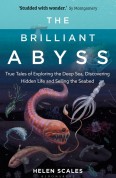The Brilliant Abyss: Exploring the Majestic Hidden Life of the Deep Ocean and the Looming Threat that Imperils It
By Helen Scales
Atlantic Monthly Press, 2021; 304 pages; $27.00
Life is strange, but nowhere on Earth is it stranger than in the abyss, the deepest part of the ocean. Is it any wonder, given the extreme environment there, that its inhabitants seem so odd? Time in the abyss, where sunlight cannot penetrate, is perpetually pinned at midnight, and pressures are hundreds of times that of the atmosphere on land. Bioluminescent organisms, of fantastic shapes, swim in self-created auras of light amidst the darkness, feeding on a “snow” of organic material sinking from above. Amorphous creatures burrow in the muddy abyssal plain, at an average depth of 12,500 feet, a vast area broken here and there by seamounts, the cone-shaped or flat-topped remnants of old volcanoes. Scattered about, hydrothermal vents percolate hot mineral-rich water, erecting fantastic spires whose unique ecosystems subsist on geochemical energy, not photosynthesis. Elsewhere, at tectonic plate boundaries, the seafloor is broken by trenches, plunging miles further into what is known as the hadal zone, named for the Greek god of the underworld, and even there, tiny invertebrates survive on the occasional morsel that falls their way.
Thanks to modern technology, especially unmanned submersibles, abyssal research is experiencing a golden age. Helen Scales, a marine biologist who is also a gifted storyteller, takes the reader on several expeditions that rely on these devices, and describes the bizarre life forms that have recently come to light. Among some of the most memorable: the pig’s rump (Chaetopterus pugaporcinus), a segmented worm, one of whose segments has swelled into a floatation device that resembles a pair of porcine buttocks; the scaly-foot snail, Chrysomallon squamiferum, whose foot looks like it is covered in chain-mail, which is not far-off, since the scales are made of iron, as is its shell; amphipods, shrimp-like crustaceans that scavenge the deepest trenches, who keep their shells from dissolving away under the enormous pressure by covering themselves in an aluminum gel they synthesize from the mud at the bottom.; crabs with hairy chests (one named after David Hasselhoff); sponges that sneeze; sea-cucumbers with long bushy tails, officially called Psychropotes longicauda, but informally the “gummy squirrel.” With every new discovery, nature seems to be saying, “You just can’t make this stuff up.”
At the same time that the abyssal world has opened to scientific study, it has also opened to assault. Fishermen, always searching for new resources as overfishing decimates known populations, have trawled further and further down, exploiting such abyssal fish as the slimehead, rebranded as the orange roughy (Hoplostethus atlanticus), even though it is unclear how big a catch is sustainable. Mining companies eye seamounts and vent fields as sources of metallic elements, such as manganese, nickel, copper, and cobalt. And as is well known, the oceans have become trash accumulators for all the detritus of civilization; candy wrappers and plastic bags have even been spotted in the Mariana Trench, seven miles below the surface. These threats are all the more menacing because so much remains to be learned about the unseen world of the abyss. If they can be averted, Scales concludes, “The deep sea will never run out of things for us to dream about.” --LAM
